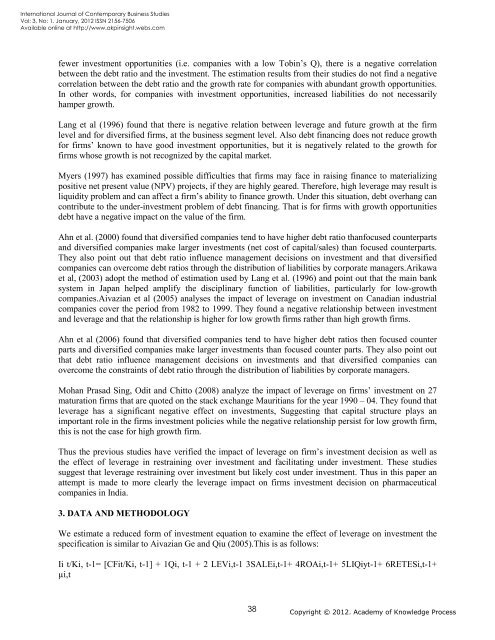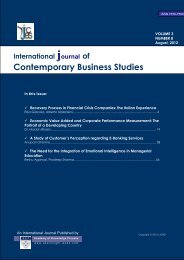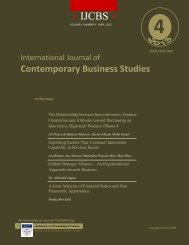Contemporary Business Studies - Academy of Knowledge Process ...
Contemporary Business Studies - Academy of Knowledge Process ...
Contemporary Business Studies - Academy of Knowledge Process ...
You also want an ePaper? Increase the reach of your titles
YUMPU automatically turns print PDFs into web optimized ePapers that Google loves.
International Journal <strong>of</strong> <strong>Contemporary</strong> <strong>Business</strong> <strong>Studies</strong><br />
Vol: 3, No: 1. January, 2012 ISSN 2156-7506<br />
Available online at http://www.akpinsight.webs.com<br />
fewer investment opportunities (i.e. companies with a low Tobin’s Q), there is a negative correlation<br />
between the debt ratio and the investment. The estimation results from their studies do not find a negative<br />
correlation between the debt ratio and the growth rate for companies with abundant growth opportunities.<br />
In other words, for companies with investment opportunities, increased liabilities do not necessarily<br />
hamper growth.<br />
Lang et al (1996) found that there is negative relation between leverage and future growth at the firm<br />
level and for diversified firms, at the business segment level. Also debt financing does not reduce growth<br />
for firms’ known to have good investment opportunities, but it is negatively related to the growth for<br />
firms whose growth is not recognized by the capital market.<br />
Myers (1997) has examined possible difficulties that firms may face in raising finance to materializing<br />
positive net present value (NPV) projects, if they are highly geared. Therefore, high leverage may result is<br />
liquidity problem and can affect a firm’s ability to finance growth. Under this situation, debt overhang can<br />
contribute to the under-investment problem <strong>of</strong> debt financing. That is for firms with growth opportunities<br />
debt have a negative impact on the value <strong>of</strong> the firm.<br />
Ahn et al. (2000) found that diversified companies tend to have higher debt ratio thanfocused counterparts<br />
and diversified companies make larger investments (net cost <strong>of</strong> capital/sales) than focused counterparts.<br />
They also point out that debt ratio influence management decisions on investment and that diversified<br />
companies can overcome debt ratios through the distribution <strong>of</strong> liabilities by corporate managers.Arikawa<br />
et al, (2003) adopt the method <strong>of</strong> estimation used by Lang et al. (1996) and point out that the main bank<br />
system in Japan helped amplify the disciplinary function <strong>of</strong> liabilities, particularly for low-growth<br />
companies.Aivazian et al (2005) analyses the impact <strong>of</strong> leverage on investment on Canadian industrial<br />
companies cover the period from 1982 to 1999. They found a negative relationship between investment<br />
and leverage and that the relationship is higher for low growth firms rather than high growth firms.<br />
Ahn et al (2006) found that diversified companies tend to have higher debt ratios then focused counter<br />
parts and diversified companies make larger investments than focused counter parts. They also point out<br />
that debt ratio influence management decisions on investments and that diversified companies can<br />
overcome the constraints <strong>of</strong> debt ratio through the distribution <strong>of</strong> liabilities by corporate managers.<br />
Mohan Prasad Sing, Odit and Chitto (2008) analyze the impact <strong>of</strong> leverage on firms’ investment on 27<br />
maturation firms that are quoted on the stack exchange Mauritians for the year 1990 – 04. They found that<br />
leverage has a significant negative effect on investments, Suggesting that capital structure plays an<br />
important role in the firms investment policies while the negative relationship persist for low growth firm,<br />
this is not the case for high growth firm.<br />
Thus the previous studies have verified the impact <strong>of</strong> leverage on firm’s investment decision as well as<br />
the effect <strong>of</strong> leverage in restraining over investment and facilitating under investment. These studies<br />
suggest that leverage restraining over investment but likely cost under investment. Thus in this paper an<br />
attempt is made to more clearly the leverage impact on firms investment decision on pharmaceutical<br />
companies in India.<br />
3. DATA AND METHODOLOGY<br />
We estimate a reduced form <strong>of</strong> investment equation to examine the effect <strong>of</strong> leverage on investment the<br />
specification is similar to Aivazian Ge and Qiu (2005).This is as follows:<br />
Ii t/Ki, t-1= [CFit/Ki, t-1] + 1Qi, t-1 + 2 LEVi,t-1 3SALEi,t-1+ 4ROAi,t-1+ 5LIQiyt-1+ 6RETESi,t-1+<br />
µi,t<br />
38<br />
Copyright © 2012. <strong>Academy</strong> <strong>of</strong> <strong>Knowledge</strong> <strong>Process</strong>
















